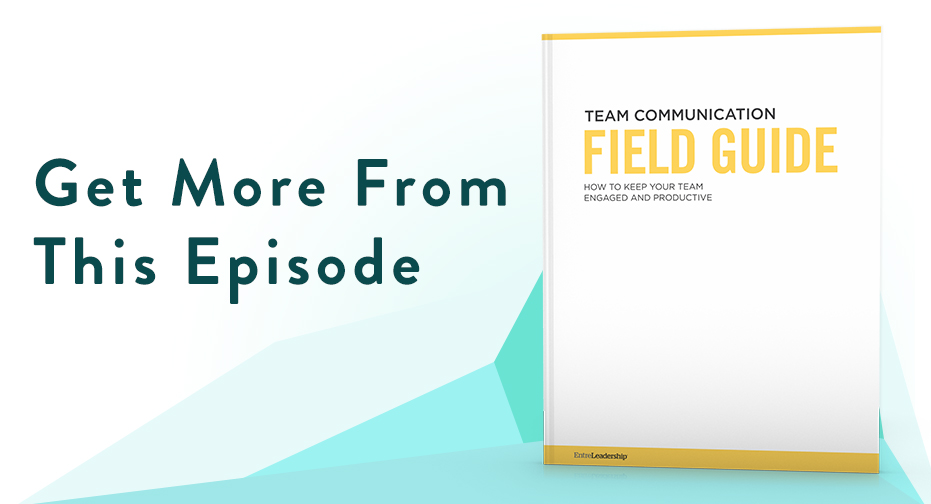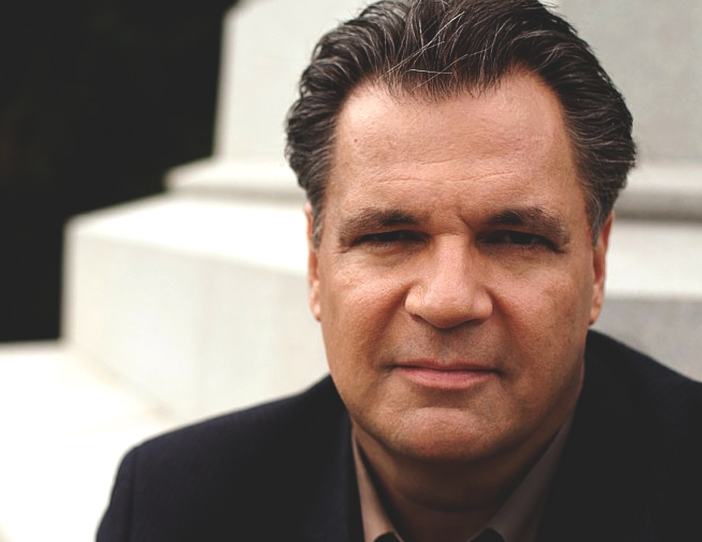
Episode Description
I don’t know many people who love meetings.
And it’s odd, because the idea of getting together to collaborate on a big idea or solve a problem thrills most business leaders.
But something about a “meeting” just sucks all the energy out of the room.
That’s because most of us are just plain bad at meetings.
As a result, we end up wasting the time of our colleagues and employees (and the payroll dollars their time represents). And what’s worse, we don’t end up actually solving the problem that prompted the meeting in the first place.
But with a little intention, we can make meetings not just productive, but also energizing and fun.
That’s why I asked Daniel Tardy of EntreLeadership to come on the podcast and tell us nine things we can do that will make our meetings more productive and more fun. With his advice, you can lead dynamic meetings that bring out the best in your team and actually move the needle for your business.
#1: Set an agenda
We’ve all been in a meeting with a rambler, haven’t we? The conversation loses its focus, and the meeting loses its purpose, too.
A short agenda solves this problem. You don’t have to call it an “agenda” if that feels too corporate. It’s, in Daniel’s words, “just writing out two or three objectives on the whiteboard. It just centers everybody. It’s almost like a little goal for the meeting.” You go in knowing exactly why the meeting is important and what it’s going to do for your business.
So if someone starts to ramble or take a detour, you can deftly reference the whiteboard, hit the reset button, and get the meeting back on track.
This means that you, as the leader, need to schedule the time to create and send the agenda around ahead of time, so everyone comes in with clear expectations.
#2: Respect the clock
Steve Jobs was famous for twenty-minute meetings. He didn’t think there were many things that needed more than twenty minutes of his time.
As Daniel points out, sometimes the work expands or contracts to fill the space you allot. So whether you set a meeting for two hours or twenty minutes, that’s the time you’ll give it.
Whether you set a meeting for two hours or twenty minutes, that’s the time you’ll give it.
I asked Daniel how long he typically sets his meetings for. He told me:
“They’re all different. We’ve got ten minute meetings. We’ve got stand-ups. We’ve got some that do need an hour, and we take an hour. I’m closer to the Steve Jobs mindset, thirty to forty-five minutes should be tops. Otherwise, we probably need to have some kind of strategic off-site meeting.”
Whatever length you settle on for a meeting, stick to it. Be efficient with your communication. Remember that the meeting costs your organization money. And if you get a “ping pong” situation where two people are going back and forth, gently interrupt and encourage them to finish the conversation afterward, resolve the discussion, and tell everyone what they decided.
#3: Limit the number of attendees
I recently had a meeting in Ohio to help out some folks with their marketing strategy. They wanted sixty people in the room. Sixty!
You only want people in the room who have agency to create change around the topic you’re discussing.
Daniel makes another great point about keeping your meetings small, saying that “every time you add another person, you’re a little bit less likely to get the last ten percent of truth.”
To make a meeting effective, you need transparency. And that means everybody around the table needs to be able to say what he or she really thinks. “The nature of a bigger group,” Daniel says, “is we’re just a little bit more careful and political about our statements, and we don’t want that. That’s not how the magic happens. That’s not how we drive ideas forward.”
#4: Start on time
Ah, there’s nothing like the feeling of waltzing into a meeting late, holding your Starbucks coffee you clearly stopped off for on the way.
We’ve all done it, and we’ve all had it done to us by others.
And it can be hard to arrive to meetings on time, especially when other meetings out of your control have run long, or someone catches you in the hall on the way there.
But arriving to meetings on time isn’t just a matter of how our days are scheduled or even how busy we are. Daniel encourages us to see it as a matter of respect: “When you are on time, you’re saying to the other person that you’re meeting with, I respect you and I believe in you. That’s the foundation for all relationships.”
Starting on time also gives your meeting and the topic you’re there to discuss more weight and significance, which in turns helps everybody contribute at a high level.
#5: Go device-free
I don’t know about you, but I’ve found that having my phone around me makes it feel like there’s another person in the room. If it’s not available, it’s just you and me. And that brings a special dynamic to a conversation.
That’s why Daniel suggests you not check your phone or your email during meetings:
If we have something that’s important enough for us all to get together and talk about, it’s important enough for me to be fully present.
“If you can turn [your phone] off and completely focus on the meeting, you can take less time in the meeting. When you’re fully present with people in the conversation, you’re respecting their time, and you’re saying, ‘I’m all in.’ If we have something that’s important enough for us all to get together and talk about, it’s important enough for me to be fully present.”
Of course, a lot of us take notes on our laptops during meetings or have our phones on hand to quickly look things up. It’s not meant to be a hard and fast rule, simply a way to make sure we are fully present and contributing well in the meetings we attend.
#6: Be aware of physical needs
No matter how important or even engaging a meeting is, at some point, your biology is going to speak up.
Your stomach will get empty, your bladder will get full, and you will just need a break.
As leaders, we’ve got to be mindful of what Daniel calls “the physiological components to the energy in the room.”
It might mean bringing in donuts or coffee. It might mean having stretch breaks. It might mean scheduling your meetings at higher-energy times rather than after lunch or at 4:00.
As Daniel says, “When you’re calling the meeting, you’ve got to be respectful enough of other people there to ask, ‘What’s going to make this engaging?’”
#7: Keep office hours
Flex time and remote work have their benefits, and they’ve opened up a lot of possibilities to do business in new ways.
But for us at StoryBrand, we just get a lot more done when everybody is in the office. We can communicate more easily. I like knowing that we’re in the office during particular times, so we can quickly have one-off conversations and collaborate on problems. We’re not bound up in meetings.
As Daniel points out, “There’s an inherent accountability and engagement factor when you’re around peers and they’re working, and you see them working, and if you’re not working, you’re going to be seen as not working.”
It may not fit your culture, but if you struggle to even get meetings scheduled due to remote and flex hours, it might be worth a 30-day “office hours” experiment to disrupt the status quo and see what happens.
#8: Try a daily stand-up
A common challenge in business, especially as your organization grows, is trying to keep everybody in the loop. You’ll find you’re having small meetings and one-off conversations repeating the same information multiple times, and there are still people in the dark.
The solution? Try a daily “stand up” meeting. These are short, informal meetings where everybody shares what they’re working on, the small wins they’ve had, and where they’re stuck. You stay standing the whole time, which keeps the meeting moving. A stand-up shouldn’t be more than about 15 minutes.
With these short meetings, Daniel says, “Everybody feels more unified. We can celebrate together in stand-ups. We can talk about big challenges we’re facing. It’s almost like a little mini staff meeting, but it’s super quick. Everybody gets to participate and talk.”
#9: Think like a director
The director of the movie isn’t the star of the show. The director uses creativity and strategy to maximize the end result. As a leader, that’s your job in a meeting. “Ultimately,” Daniel says, “the fruit of the meeting is a symphony, a team, coming together to create this beautiful piece of music, that’s the art or the work that our organization produces.”
That means you’re going to prep on the front end to maximize your team’s time together. You’re going to find new and interesting ways to get the best contributions from each person at the table. You’re going to follow up afterward with conversations that help the ideas take shape.
—
Who isn’t ready to put a stop to painful, monotonous meetings? Try Daniel’s tips and you’ll be amazed at how much more productive and energized your team becomes when you gather together.
What strategies help you and your team run better meetings? Share your wisdom with us in the comments.

Click below to download the “Team Communication Field Guide” and learn how to keep your team engaged and productive.
Executive producer: Tim Schurrer
Additional production and editing: Chad Snavely











